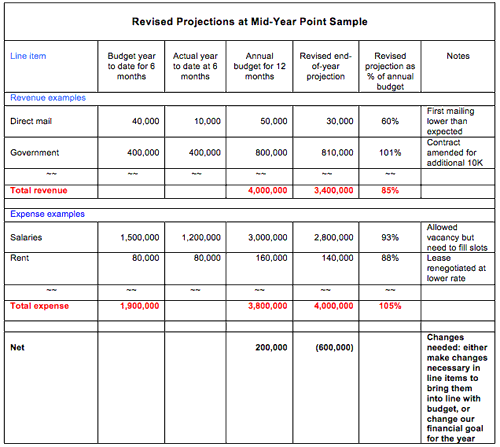Focus on the Destination, Not the Route (Budget)!
Jeanne Bell argues it’s time to stop looking at budgets and pay attention instead to projections and financial goals.

Allow your nonprofit to incorporate new information for financial choices.
In this precarious era, annual budgets have become like new cars: they lose value even as you drive them off the lot.
How many of us could predict even a few months ago what might take place to affect our donations, our foundation grants, or our government contracts? The entrenched practice in many nonprofits of using the approved budget as the primary financial reference point just isn’t suited to effective financial leadership anymore.
Focusing on the annual budget — adopted months ago — is like setting a course on the high seas and staying with it even when unexpected rocks suddenly appear, or a more favorable, alternative route opens up ahead. Instead of being locked into a carefully constructed annual budget, we need to be freed up to incorporate new information as we make continuous financial choices.
Shifting the focus
What does it mean to shift from a focus on budget-to-actual to a focus on rolling projections? First, as an early part of the budget process, management and the board should commit to an overall financial goal for the year. In some cases they’ll want to finish the year with a surplus, in other years, to break even, and at other times they’ll want to invest reserve funds through a deficit budget (see my last column for more on these options). This choice and commitment becomes fundamental to all financial decisions throughout the year. This overall financial goal for the year — rather than the adhering to line items that make it up — must become the business driver.
In step with this commitment, effective management teams review the organization’s performance each month when the financial statements come out. This review fulfills two key responsibilities:
- Assessing financial performance year to date, and
- Surfacing any new, critical financial information.
The first is the traditional look at actual performance compared to budget, or variance. The latter means asking ourselves things like: “Is this 20% drop in direct mail donations likely to hold for the rest of the year?” and “Are there foundation grant assumptions in the budget that look shaky?” and “If Jane does resign to go back to school next month, do we absolutely need to replace her?”
It’s this discussion on the future that enables timely financial projection and decision-making. For instance, the fact that Jane’s salary is in the budget for the whole year does not mean that the organization shouldn’t take a second look at her job and determine if this is a good moment to save money rather than immediately fill the position. Instead of doing anything because “it’s in the budget,” leaders are quick to use new financial data to make the best decisions they can make in real time.
Approaching midyear, staff should start a process to update their financial assumptions for the rest of the year, reviewing all major income and expense line items. This analysis should be presented in a new year-end projection column added to the monthly income statement shared with staff and board. This additional year-end projection column does not replace the approved annual budget column. It provides a helpful picture of staff’s new best estimate of where the organization will end the year. As the organization approaches the fourth quarter and begins building next year’s annual budget, it is these more recent projections, not last year’s budget, that become the starting point for next year’s planning.
 As you can see in this excerpt from a report, the variance from budget is important, but not as a pointer to what decisions need to be made in order to reduce variances. Instead, variances are important as tools to get to the more important guide: the projection for the end of the year. In this instance, the organization had budgeted for a $200,000 surplus for the year. Management’s mandate is to meet that goal, rather than to stick to the budgeted revenue and expense items.
As you can see in this excerpt from a report, the variance from budget is important, but not as a pointer to what decisions need to be made in order to reduce variances. Instead, variances are important as tools to get to the more important guide: the projection for the end of the year. In this instance, the organization had budgeted for a $200,000 surplus for the year. Management’s mandate is to meet that goal, rather than to stick to the budgeted revenue and expense items.
This projection also illuminates the choice that management and the board can make at this point: whether to institute changes that will come closer to the financial goal, or to change the financial goal.
Not a reset button
The most important reason to make this shift in focus to rolling projections is that the fiscal year end provides no magical re-set opportunity. We don’t get to start over, leaving behind last year’s financial missteps to try again with a new budget. We’re charged with managing the organization financially every day; each one of our major choices has a lasting impact on the organization’s financial health. When we use the most current information we have rather than rely on stale assumptions from last year, we are freed from the weight of a budget set in stone to attain our true goal of managing the organization more effectively.
An important and fairly easy step to take now: Do a revised projection at the end of the current quarter, and have the management team and the board discuss it. Consider these questions:
- What are the key discrepancies between what’s in the budget and what we now believe is going to happen?
- Given this information, do we need to expect a different financial outcome for the year than what the budget was meant to achieve?
- What changes need to be made in the management of any revenue or expense items?
- What implications are there for the next fiscal year, given the projected financial result of this year?
Taking new information into account has always been something of a problem in nonprofits that use the annual budget as a guide throughout the year. But the current economic climate makes it even more important to see financial projections as the dynamic, changing financial document that helps management and the board think about what might need to be done differently.
See also:
- Nonprofit Budgets Have to Balance: False!
- Finance Fear Factor Ratios
- A Nonprofit Dashboard and Signal Light for Boards
You might also like:
- Don’t Call it a Crisis Plan: How Nonprofits Can Proactively Plan for Turbulent Times
- Can Nonprofit Boards Vote By Email?
- Your IRS Form 990 Questions Answered
- Vision Before Strategy: A Nonprofit’s Guide to Defining Success
- Hedging Your Bets: Rajiv Shah, and the Limits of Large-Scale Changemaking
You made it to the end! Please share this article!
Let’s help other nonprofit leaders succeed! Consider sharing this article with your friends and colleagues via email or social media.
About the Author
Jeanne Bell, MNA, is CEO of CompassPoint Nonprofit Services, and consults to nonprofits in business planning, financial systems, and sustainability. She co-authored Financial Leadership for Nonprofit Executives (Fieldstone).
Articles on Blue Avocado do not provide legal representation or legal advice and should not be used as a substitute for advice or legal counsel. Blue Avocado provides space for the nonprofit sector to express new ideas. The opinions and views expressed in this article are solely those of the authors. They do not purport to reflect or imply the opinions or views of Blue Avocado, its publisher, or affiliated organizations. Blue Avocado, its publisher, and affiliated organizations are not liable for website visitors’ use of the content on Blue Avocado nor for visitors’ decisions about using the Blue Avocado website.








This is why I like dashboards. It helps the board focus on trends and not whether we are paying more or less for postage than projected.
Hi Kate,
I think I know what you mean—and love this point—can you say a bit more or give an example that will help our readers apply your suggestion?
Thanks!
Jeanne
I can offer an example: we projected individual donor giving to a certain amount that was actually exceeded in a given quarter last year (by the numbers). Looking deeper, we found that one particular donor made an above-normal donation due to an inheritance THEY received (if we had gotten the bequest it would have been logged differently , and not shown up in individual giving). Factoring out that one-time isolated event, the results instead indicated that our individual donor giving was trending down, not up – and of course the picture, and resulting strategy changed focus accordingly.Steve
Jeanne,
In response to your question I think that Steve’s example is perfect. It’s valuable to pay attention to both the numbers when comparing budget to actual AND to how they came to be. As another example, an organization that budgets $500,000 in grants may meet their budget by receiving an unbudgeted one-time federal stimulus grant for $200,000 while at the same time being declined for 4 budgeted smaller grants from long term funders who have changed their focus areas. The $200,00 was helpful in the short term in “making budget” but it’s essential to pay attention to the variance based on the assumptions that went in to the budget. Those assumptions, and lessons learned about them, become the basis of future planning. What can they learn about how they predict grant income?
Absolutely agree. I sometimes lose jobs beaucse of budget or a friend offers to do it. May as well call them ex friend beaucse it is very rare that this works out. Book a good photographer and your happy for the rest of your life.